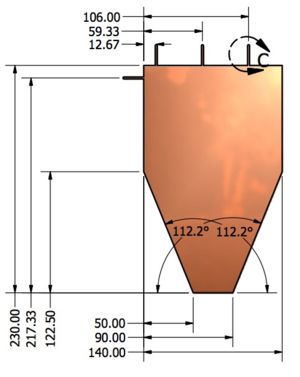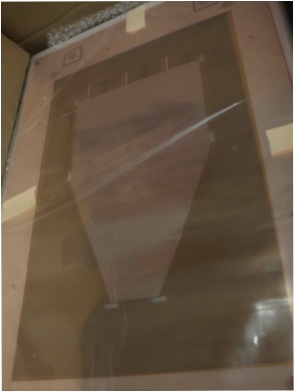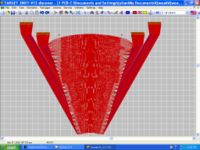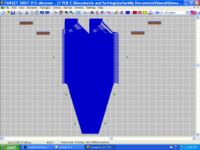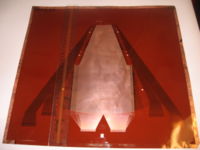2008 NSF Proposal
NSF Proposal Guide
d. Project Description (including Results from Prior NSF Support)
(i) Content
All proposals to NSF will be reviewed utilizing the two merit review criteria described in greater length in GPG Chapter III.
The Project Description should provide a clear statement of the work to be undertaken and must include: objectives for the period of the proposed work and expected significance; relation to longer-term goals of the PI's project; and relation to the present state of knowledge in the field, to work in progress by the PI under other support and to work in progress elsewhere.
The Project Description should outline the general plan of work, including the broad design of activities to be undertaken, and, where appropriate, provide a clear description of experimental methods and procedures and plans for preservation, documentation, and sharing of data, samples, physical collections, curriculum materials and other related research and education products. It must describe as an integral part of the narrative, the broader impacts resulting from the proposed activities, addressing one or more of the following as appropriate for the project: how the project will integrate research and education by advancing discovery and understanding while at the same time promoting teaching, training, and learning; ways in which the proposed activity will broaden the participation of underrepresented groups (e.g., gender, ethnicity, disability, geographic, etc.); how the project will enhance the infrastructure for research and/or education, such as facilities, instrumentation, networks, and partnerships; how the results of the project will be disseminated broadly to enhance scientific and technological understanding; and potential benefits of the proposed activity to society at large.
Intellectual Merit of the Proposed Activity
The ISU Physics Program
The experiment and the measurement of at large in Jefferson Lab's Hall B represent the main components of the principal investigator's physics program. Both components are the continuation of the PI's previous work in parity violating electron scattering as a Ph.D. student and polarized structure functions as a postdoctoral researcher based at Jefferson Lab. While the main goal of the experiment is to measure the weak mixing angle (), the PI has found an opportunity to use the same apparatus to measure a new low energy fundamental constant known as described below. Such an experiment using the apparatus would require 1 week to measure an inelastic parity-violating asymmetry which is an order of magnitude larger than the asymmetry. While a postdoctoral researcher based at Jefferson Lab, the PI began developing a program to measure the polarized to unpolarized down quark distribution () in the nucleon. The program was recently awarded 80 days of beam time by Jefferson Lab's PAC 30. Further details of the physics program are given in the subsections below.
Q_{weak}
The experiment (E05-008) will use parity violating (PV) electron-proton scattering at very low momentum transfers to measure the weak mixing angle . The dominant contribution to the PV asymmetry measured by is given by the weak charge of the proton, $Q_W^p = 1-4\sin ^2 \theta _W$, with small corrections at order $Q^4$ from nucleon electromagnetic form factors. This measurement will be a standard model test of the running of the electroweak coupling constant sin$^2$($\theta_W$). Any significant deviation of $\sin ^2 \theta _W$ from the standard model prediction at low $Q^2$ would be a signal of new physics, whereas agreement would place new and significant constraints on possible standard model extensions including new physics. The experiment is scheduled for installation in the beginning of 2010. The role of the principal investigator in this program is described in section~\ref{section:QweakDetector}. A brief description of the physics behind the Qweak experiment is given below.
The PV asymmetry measured by inclusive electron scattering is driven by the exchange of a neutral weak Z$^0$ boson. The asymmetry may be expressed as
\begin{eqnarray}
~\cite{ReyaSchilcher74},
\label{eq:PVelasticAsym} \end{eqnarray}
where $\sigma _+(\sigma_-)$ is the cross section for the elastic
scattering of electrons of positive (negative)
helicity, $\tau$, $\varepsilon$, and $\varepsilon ^{\prime}$ are
kinematic factors depending on
$Q^2$,
$M$ is the mass of the proton, $G_F$ is the Fermi coupling
constant, $\alpha$ is the electromagnetic
coupling constant, $Q^2$ is the square of the four momentum
transfer, $\sin ^2 \theta _W$ is the weak
mixing angle, $\theta _e$ is the electron laboratory scattering
angle, and $\sigma _p$
is the Mott cross section. The Sachs electromagnetic and
neutral weak electric and magnetic form factors are denoted as and , respectively. The above asymmetry is amplified by the interference between
the weak and electromagnetic interactions.
The limit $\theta
\rightarrow 0$, $\epsilon \rightarrow 1$,
and $\tau \ll 1$, in Eq.~\ref{eq:PVelasticAsym} is taken in order
to see how a measurement of the PV asymmetry in elastic
electron-proton
scattering at very low $Q^2$ and very small electron scattering
angles can be used to test the
Standard Model.
The resulting asymmetry becomes:
\begin{eqnarray} , \end{eqnarray} where $F^p$ is a form factor. Neglecting radiative corrections, the leading term in this equation is simply $Q_W^p = 1-4\sin ^2 \theta _W$. The $B(Q^2 )$ is the leading term in the nucleon structure defined in terms of neutron and proton electromagnetic and weak form factors. The contributions contained in $B(Q^2 )$ (which enters to order $Q^4$) can be reduced by going to lower $Q^2$ values; however, this also reduces the sensitivity to $Q_W^p$ (which enters to leading order in $Q^2$) making it statistically more difficult to measure. The value of $B(Q^2 )$ can be determined experimentally by extrapolating measurements made by the ongoing program of forward angle PV experiments at higher $Q^2$~\cite{HAPEX,G0,A4}. The optimum value of $Q^2$ to minimize hadron structure uncertainties and at the same time maximize our sensitivity to $Q_W^p$ is estimated to be near $Q^2 = 0.03$~(GeV/c)$^2$ \cite{Qweak}.
\begin{figure}[htbp] %\vspace{-1in} \centerline{ \scalebox{0.5} [0.5]{\includegraphics{Graphs/s2w_2004_4_new_2.eps}}} \caption{The dependence of $\sin^2 \theta_W$ as a function of $Q^2$ cast in the MS bar scheme by reference~\cite{Erler}. The solid line represents the Standard Model prediction. The results from three experiments (APV~\cite{APV}, $Q_W(e)$~\cite{E158}, $\nu$-DIS~\cite{NuTeV} ,Z-pole~\cite{Zpole} are shown together with the expected precision from the experiment (Q$_W(p)$~\cite{Qweak}. } \label{fig:newphysics} \end{figure}
An essential prediction of the Standard Model is the variation of $\sin ^2 \theta _W$ with $Q^2$, often referred to as the ``running of $\sin ^2 \theta _W$. Testing this prediction requires a set of precision measurements at a variety of $Q^2$ points, with sufficiently small and well understood theoretical uncertainties associated with the extraction of $\sin ^2 \theta _W$. It also requires a careful evaluation of the radiative corrections to $\sin ^2 \theta _W$ in the context of the renormalization group evolution (RGE) of the gauge couplings. Such tests have been crucial in establishing QCD as the correct theory of strong interactions \cite{Hin00}, and the RGE evolution of the QED coupling has also been demonstrated experimentally \cite{TOP97,VEN98,OPAL00,L300}. The gauge coupling of the weak interaction, however, represented at low energies by the weak mixing angle $\sin ^2 \theta _W$, has not yet been studied successfully in this respect.
Shown in Fig.~\ref{fig:newphysics} is the Standard Model prediction in a particular scheme \cite{QweakAp} for $\sin ^2 \theta _W$ versus $Q^2$ along with existing and proposed world data. As seen in this figure, the very precise measurements near the $Z^0$ pole merely set the overall magnitude of the curve; to test its shape one needs precise off-peak measurements. To date, there are only three off-peak measurements of $\sin ^2 \theta _W$ which test the running at a significant level: one from APV~\cite{APV}, one from high energy neutrino-nucleus scattering~\cite{NuTeV}, and the recently completed SLAC experiment E-158(Q$_w$(e))~\cite{E158}. The measurement of $Q_W^p$ described here will be performed with smaller statistical and systematic errors and has a much cleaner theoretical interpretation than existing low $Q^2$ data. In addition, this measurement resides in the semi-leptonic sector, and is therefore complimentary to experiment E-158 at SLAC, which has determined $\sin ^2 \theta _W$ from PV $\vec e e$ (Moller) scattering (which resides in the pure leptonic sector) to roughly a factor of two less precision at low $Q^2$ \cite{E158}. The total statistical and systematic error anticipated on $Q_W^p$ from these measurements is around 4\% \cite{Qweak}, corresponding to an uncertainty in $\sin ^2 \theta _W$ of $\pm$0.0007, and would establish the difference in radiative corrections between $\sin ^2 \theta _W (Q^2 \approx 0)$ and $\sin ^2 \theta _W (M_Z )$ as a 10 standard deviation effect.
Measuring $d_{\Delta}$ using the PV $N\rightarrow \Delta$ Transition at Low $Q^2$
Interest in inelastic PV physics has been bolstered by the discovery of a new radiative correction for the PV $N\rightarrow \Delta$ transition~\cite{Zhu012} resulting in a $Q^2$ independent asymmetry that does not contribute to elastic PV electron scattering. The result is a non-vanishing PV asymmetry at $Q^2 = 0$ . The new correction is the result of a photon coupling to a PV hadron vertex and is referred to as the so called ``anapole contribution which has no analog in the elastic channel. The authors in Ref.~\cite{Zhu012} use Siegert's theorem to show that the $Q^2$ independence is the result of a cancellation of the 1/$Q^2$ term from the photon propagator and the leading $Q^2$ dependence from the anapole term. The leading component from the contribution of this transition amplitude is proportional to $\omega ~(\omega = E_f -E_i )$ times the PV electric dipole matrix element and is characterized by a low energy constant $d_{\Delta}$. A measurement of the PV asymmetry in the $N\rightarrow \Delta$ transition at the photon point, or at very low $Q^2$, henceforth called the Siegert contribution, would provide a direct measurement of the low energy constant $d_{\Delta}$.
The low energy constant $d_{\Delta}$ is a fundamental constant which has implications to other long standing physics questions. The same PV electric dipole matrix element which results in $d_{\Delta}$ also drives the asymmetry parameter ($\alpha_{\gamma}$) in radiative hyperon decays, e.g. $\Sigma ^+ \rightarrow p\gamma$. Although Hara's theorem \cite{Hara64} predicts that the asymmetry parameter ( $\alpha_{\gamma}(\Sigma ^+ \rightarrow p\gamma$)) should vanish in the exact SU(3) limit, the Particle Data Group~\cite{PDGAlphaSigma} reports a measured value of $\alpha_{\gamma}(\Sigma ^+ \rightarrow p\gamma) =$-0.72$\pm$ 0.08. While typical SU(3) breaking effects are of order $(m_s - m_u )/1$GeV $\sim$ 15\%, the above asymmetry parameter is experimentally found to be more than four times larger. A solution proposed by the authors of Ref.~\cite{Bor99} involves including high mass intermediate state resonances $(1/2 ^- )$, where the weak Lagrangian allows the coupling of both the hyperon and daughter nucleon to the intermediate state resonances, driving the asymmetry parameter to large negative values. This same reaction mechanism was also shown to simultaneously reproduce the $s-$ and $p-$ wave amplitudes in non-leptonic hyperon decays, which has also been a long standing puzzle in hyperon decay physics. If the same underlying dynamics is present in the non-strange sector ($\Delta S = 0$) as in the strangeness changing sector ($\Delta S = 1$), one would expect $d_{\Delta}$ to be enhanced over its natural scale ($g_{\pi}$ = 3.8$\times 10^{-8}$, corresponding to the scale of charged current hadronic PV effects \cite{Des80,Zhu00}). The authors of Reference\cite{Zhu012} estimate that this enhancement may be as large as a factor of 100, corresponding to an asymmetry of $\sim$ 4 ppm, comparable to the size of the effects due to the axial response and therefore easily measurable. Thus, a measurement of this quantity could provide a window into the underlying dynamics of the unexpectedly large QCD symmetry breaking effects seen in hyperon decays.
Dr. Forest submitted a Letter of Intent (LOI-03-105) to JLab PAC24 which outlined an experiment to measure $d_{\Delta}$ using the $Q_{weak}$ apparatus \cite{Qweak}. As shown in Figure~\ref{fig:N2Delta_Asym}, a statistical precision of $<$ 0.1 ppm can be achieved at a $Q^2$ value of 0.028 GeV$^2$ in less than a week. The favorable reviews received have encouraged the PI to submit a full proposal once the Q$_{weak}$ run schedule has become firm.
\begin{figure}[htbp]
\begin{center}{
%\scalebox{0.4}[0.3]{\rotatebox{-90}{\includegraphics{Graphs/N2Delta_Asym.eps}}}
\scalebox{0.4} [0.4]{\includegraphics{Graphs/A_d_Delta_Prec.xfig.eps}}
}
\caption{Expected precision of the measured asymmetry using the
Q$_{weak}$ apparatus compared
with the expected asymmetry for several values of the low energy
constant $d_{\Delta}$. The rectangular box indicates both the
Q$^2$ bin and the asymmetry uncertainty.}
\label{fig:N2Delta_Asym}
\end{center}
\end{figure}
ISU's Role
Dr. Forest is currently the work package manager of the Region 1 Detector and Front End electronics for Qweak. The detectors have been built and are being tested. A front end electronics system from CERN has been chosen to digitize the analog output of the detectors. Dr. Forest has been using his start up funds to develop the infrastructure needed to implement this system in Qweak. The support from this proposal will be used to complete the front end electronics installation and maintain the region 1 tracking system during the calibration phase of the Qweak experimental currently scheduled to begin installation in JLab's Hall C in early 2010.
Vector Meson and Hyperon Photoproduction with Linearly Polarized Photons
Primakoff
6 GeV A- experiment and 12 GeV PAC proposal
Prior and Future use of NSF Funds
Prior use of NSF funds
The PI's in this proposal have a strong record of receiving external funding from the NSF and DOE.
While at Louisiana Tech University, Dr. Forest received three prior NSF awards as a member of the Louisiana Tech Particle Physics Group. The first proposal entitled ``Parity Violating Electron Scattering at Jefferson Lab, was awarded in 2002 for three years in the amount of \$670,230 (NSF Award \#0244998) to Louisiana Tech University. The award supported the groups efforts building triggering electronics for the G0 backward angle measurements and for the initial development of the $Q_{weak}$ experiment. The second proposal, ``Precision Electroweak Measurements at Jefferson Lab, was awarded \$204,594 in 2006 (NSF Award \#0555390) with similar support for the next two years to continuing the Lousiana Group's efforts. Dr. Forest's MRI Proposal (\#PHYS-0321197) entitled {\small ``Collaborative Research:Development of a Particle Tracking System for the Qweak Experiment} was awarded \$131,770 on July 26, 2003 to develop the Region 1 tracking system for the Q$_{weak}$ experiment. After moving to ISU, Dr. Forest recieved a grant to continue his research efforts on Qweak as well as hist work Semi-inclusive Deep Inelastic Scattering. The status of the work supported by the above awards which the Dr. Forest was responsible for is given in section~\ref{section:QweakDetector} and shown in Figure~\ref{fig:QweakProducts}
Qweak Detector Construction
The design, construction, and testing of the Region 1 tracking system for the Qweak experiment at Jefferson Lab has been the main research activity supported by Dr. Forest's previous NSF grant. The Qweak Region 1 tracking system is one of three tracking systems designed to measure the Q2 profile of elastically scattered electrons as well as background contributions to the parity violating signal. The Region 1 tracking system is located behind the first collimator at a distance of about 550 cm from the main torus magnet ( 200 cm from the target). The collimator divides the φ acceptance into 8 regions, octants, and reduces the azimuthal acceptance by almost 30 percent. The right hand figure below shows the elastic scattering profile overlayed on top of one of the octants. The Region 1 tracking system will measure the electron scattering angle at only 2 of the octants at a time and will rotate in φ to perform measurements in the remaining octants.
The high radiation flux and the small detector footprint are two of the biggest challenges facing the Region 1 tracking system. An ionization chamber equipped with Gas Electron Multipliers (GEM) was chosen in order to accommodate the high radiation flux near the target. The GEM preamplifiers allow smaller ionization cell sizes thereby resulting in ionization chamber rise times of 50 nanoseconds or less. The ionization chamber itself is constructed from Ertalyte, a machinable plastic material which can withstand the high radiation environment. The material's strength allows the chamber to have thin walls which prevent the chamber from extending into adjacent octants. The three major components to the Qweak Region 1 detector are the GEM preamplifiers, the charge collector, and the ionization chamber are describe below.
The figure below shows the custom designed GEM preamplifier for the Qweak Region 1 tracking system. The preamplifier is a 50 micron thick kapton foil clad on both sides with 5 microns of copper. Holes are etched into the foil such that a high voltage (HV) applied across the top and bottom copper plates will create an electric field strong enough to cause charge to pass through the hole and multiply much like the avalanche region of a drift chamber. Engineers from the Idaho Accelerator Center (IAC) designed the shape of the foils and the location of 6 tabs used for HV connections, as shown in the left hand figure below. This generic design allows one to use the part for any GEM amplification stage simply by cutting off the unused HV tabs. The actual preamp is shown on the right hand side of the figure below. Although this is a simple part, it is a clear example of how the infrastructure at the IAC can be leveraged in support of our physics mission.
The charge collector for Qweak's region 1 tracking system is shown below. The copper charge collector strips are aligned in terms of the electron scattering angle θ. Each of the red strips shown in the right hand figure below is 400 microns wide and will measure the elastic electron scattering angle to within 0.1 mrad. The blue lines shown in the left hand figure are representative of the φ scattering angle. A large number of graduate student hours were needed to place each strip into the correct position using PC board design software. Software compatibility issues with the vendor were also a major time sink of several months before the part could be accurately manufactured according to our specifications. This single part represents the bulk of a graduate students effort for the past 6 months and is one example of a practical component to a students educational experience. Two charge collectors have already been received but had two small errors which have been correct. Although the vendor for this part has had production difficulties resulting in delays of several months, the part and is expected to arrive by the end of October, 2008.
The ionization chamber for the Qweak Region 1 tracking system needs to have a small profile in order to be placed less than a quarter meter after the target. A collimator in front of this detector divides the electron scattering anglular range into octants which reduce the angular acceptance range by about 30 percent. The goal was to construct a chamber which did not interfere with the other octants and be transportable between octants. The figure below shows the top half of the ionization chamber which has been built. As seen in the figure, the electron profile is enclosed by the detector acceptance and the ionization chamber frame is in the shadow of the collimator. The HV distribution board has been designed by physics undergraduate student Jordan Keough and is ready to be sent out for production. Chamber construction will be completed when the charge collector arrives from the vendor and is installed. We expect to test the chamber in August, 2008.
Future Use of NSF funds
Work Plan
A work plan time line is given below which summarizes the objectives of this proposal.
| Date | Objective |
| 9/09 | Complete testing of the Qweak Region 1 tracking system at JLAB |
| 3/10 | Complete installation of Qweak Region 1 tracking system in JLab's Hall C |
Polarized Structure Functions
\hspace{0.5in}Spin structure functions of the nucleon have been measured in deep inelastic (DIS)lepton scattering for nearly 30 years since the first experiments at SLAC. Interest increased substantially in the 80's when the EMC collaboration reported that the quark helicities made a small contribution to the overall helicity of the proton, according to their data. This ``spin crisis led to a vigorous theoretical and experimental effort over the next 20 years, with a large data set collected at CERN, SLAC, DESY and Jefferson Lab. As of today, the data indicate that between 25\% - 35\% of the nucleon spin is carried by the quark spins, with the remainder being attributed to gluon polarization and orbital angular momentum. The world data set however, has yet to resolve whether the three valence quark spins ($uud$ in the proton) follow the ``naive expectation of relativistic quark models that 60\% -- 70\% of the nucleon spin carried by quark helicities.
The interest in this field continues unabated as new experiments (COMPASS %~\cite{COMPASS} at CERN and the nucleon spin program at RHIC %~\cite{RHIC} ) are attempting to measure the low-$x$ gluon and sea quark polarization in a polarized nucleon with high precision. At large-$x$, new data from JLab address for the first time the question of the helicity structure of the nucleon in a kinematic realm where sea quark and gluon contributions are minimal thereby making one mostly sensitive to valence quarks. Examples of these results are shown in Fig.~\ref{delqJLab}. To extend this region to higher $x$ and moderate $Q^2$, one needs higher beam energies than presently available at JLab. In particular, to test various models of the asymptotic value of the virtual photon asymmetry $A_1(x)$ as $x \rightarrow 1$, one needs the upgraded CEBAF with 12 GeV beam energy.
\begin{figure} [!hbp] \begin{center}{ \scalebox{0.4} [0.5]{\includegraphics{Graphs/delq_new1.eps}} \scalebox{0.4} [0.5]{\includegraphics{Graphs/deltad_CLAS12.eps}} } \caption{The polarized to unpolarized up and down quark distribution ratio. The left figure shows the results from recent JLab experiments on the virtual photon asymmetry $A_1$ for the proton, Deuteron~\cite{EG2DeltaD} and neutron ($^3$He)~\cite{HallADeltaD}. The right figure represents the proposed measurements. The expected data have been draw along the pQCD and CQM prediction. } \label{delqJLab} \end{center} \end{figure}
The comprehensive data set to be
collected by experiment PR12-06-109 will contribute
substantially to our knowledge of polarized parton distribution
functions for all quark flavors and even the polarized
gluon distribution $\Delta g$. Through Next-to-Leading Order (NLO) analysis
of the world data on inclusive DIS (using the DGLAP
evolution equations), one can constrain these
distribution functions and their integrals. Existing CLAS data
from 6 GeV have already made an impact on these fits. The
expected data from the proposed experiment at 11 GeV will yield
further dramatic reductions in the errors on these distributions.
In addition, semi-inclusive DIS (SIDIS)
data will also be collected, where in addition
to the scattered electron we will detect some of the leading
hadrons produced when
the struck quark hadronizes. These data will further constrain
the NLO fits and improve the
separation of the various quark flavors' contribution to the nucleon spin.
Baryon Spectroscopy Program
CLAS 12 DC Design and Construction
List of Currently supported students:
| Student | Classification | Expected Grad Yr |
| Julian Salamanca | Ph. D. | 2009 |
| Tamar Didbarize | Ph. D. | 2010 |
| Danny Martinez | Ph. D. | 2012 |
| Oleksei Kosinov | Ph. D. | 2012 |
| Adrianne Spilker | M.S. | 2009 |
| Saitiniyazi Shadike | M.S. | 2009 |
| Jordan Keonough | BS | 2011 |
| Nathan Lebaron | BS | 2012 |
R3 DC design
Facilities
\hspace{0.5in}The Idaho State University Department of Physics Strategic Plan identifies the use of experimental nuclear physics techniques as its focus area to addressing problems in both fundamental and applied science. The major efforts of the department include fundamental nuclear and particle physics, nuclear reactor fuel cycle physics, nuclear non-proliferation and homeland security, accelerator applications, radiation effects in materials and devices, biology and health physics. Because of this focus, the department has been characterized as one of the largest nuclear physics graduate programs in the nation with an average of over 50 graduate students. One of the key ingredients to the department's success has been the completion of the Idaho Accelerator Center (IAC) on April 30, 1999. A substantial amount of lab space (4000 sq. ft.) within the department has become available due to a combination of the IAC and a remodeling of the physics building. A detector lab with the potential to construct proto-type drift chambers in a clean room environment is currently planned as part of the lab space renovation.
The Idaho Accelerator Center (IAC) is located less than a mile away from campus and will provide a machining facility for detector construction, an electronics shop for installation of instrumentation, and beam time for detector performance studies. The IAC houses ten operating accelerators as well as a machine and electronics shop with a permanent staff of 8 Ph.D.'s and 6 engineers. Among its many accelerator systems, the Center houses a Linac capable of delivering 20 ns to 2 $\mu$s electron pulses with an instantaneous current of 80 mA up to an energy of 25 MeV at pulse rates up to 1kHz. The IAC has donated beam time to the Q$_{weak}$ project for the purpose of testing detector performance. One of the goals of these tests will be to evaluate the Q$_{weak}$ detector at high rates. The IAC is well suited for these rate tests as the Q$_{weak}$ calibration rates will be much lower than the electron and photon rates the IAC is capable of generating. A full description of the facility is available at the web site (www.iac.isu.edu).
The Beowulf REsource for Monte-carlo Simulations (BREMS) is a 12 node, 64 bit cluster housed in the ISU physics department which can support the high performance computing needs of the physics research program. This facility is the result of an investment made by NSF award PHYS-987453. This infrastructure will be an effective means for performing GEANT4 simulations of the Q$_{weak}$ experiment as well as Garfield simulations of the Region II drift chamber design. Simulation speed is increased on BREMS by running the simulation in parallel on many CPUs. A version of GEANT4 known as ParGeant4~\cite{ParGeant4} has recently been distributed which will allow these simulations to be run in parallel.
The Broader Impact of the Idaho State University Nuclear Physics Research Program
Budget Justification
The three senior personnel on this project, Dr. Phil Cole, Dr. Dan Dale, and Dr. Tony Forest, each have established physics programs at Jefferson Lab and will continue to pursue those endeavors using the support itemized in the budget. Almost 40% of the budget in this proposal is devoted to supporting several graduate students currently pursuing their Ph. D. degrees within the JLab research program. Two undergraduate students will also continue to be supported by this grant. Undergraduates supported in past years have made substantial contributions to the program while gaining research experience. The support from this grant will be used to extend those experiences to include accelerator operations. We plan to use undergraduates as operators of the accelerators we will be using to provide ionizing radiation for testing the detectors we build.
Our travel budget is based on the number of shifts we expect to take at JLAB as well as several collaboration meetings we will need to attend. The ISU group was assigned 32 CLAS shifts in 2008 which requires at most 8 trips to JLab when the shifts are taken in blocks of 4. Our past experiences indicate that the costs of an individual trip to JLAB from Idaho range between $1,200 and $2,000 per trip. We estimate that we will spend approximately $16,000 per trip in order to absorb the market fluctuations as well as the probably increases in travel costs. Each PI expects to attend at least 3 collaboration meetings per year. The PI's have substantial roles in the Qweak, PRIMEX, and CLAS collaborations. We estimate a cost of $18,000 for this travel. We also expect to present the results of our work at conferences each year and request $4,000 to defray those costs.
A shipping budget for $100 is requested to support the exchange of materials between JLab and ISU as we move towards construction of the RI tracking system for CLAS12. Our Laboratory for Detector Science expends on average $3000 in consumables each year. We expect to upgrade or replace an average of 1 computer each year which is used for data acquisition or analysis at a cost of $2000. We will also add to our data acquisition system by purchasing a NIM/VME modules at a cost of $5000. During the first we plan to purchase two gate generators for digital signal generation and a VME module for producing LVDS signals. The LVDS signal module will be used to test the front end electronics of the Qweak Region 1 tracking system. In year two we plan on purchasing F1 TDC's for the purpose of measuring the performance of Drift Chambers developed as part of the CLAS 12 GeV upgrade. We plan on purchasing several more channels of leading edge discriminators and post amplifiers in the final year to increase the number of detector channels we are capable of measuring with out current CODA based DAQ system.
